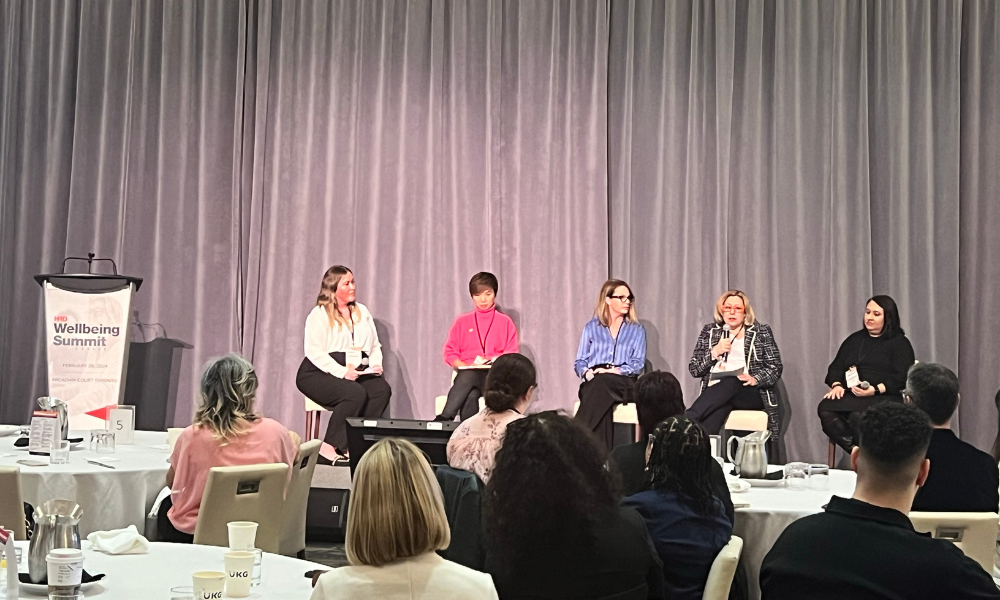
'Canadians are leaning into self-care with a profound commitment that I hadn't seen before until the pandemic'

Making employees feel heard and valued when physical and mental health is placed as a priority leads to a shift in engagement, retention, behaviour and health, said Dr. Dwight Chapin, clinic director and owner of High Point Wellness Centre.
Chapin emphasized this point at HRD’s Wellbeing Summit, which was held at Arcadian Court Toronto on February 28.
The summit featured panels and discussions on a range of topics including creating a psychologically safe workplace and successful mental wellbeing strategies to support and empower employees.
Chapin spoke to HR professionals during a fireside chat on reducing the risk of musculoskeletal conditions and chronic disease where he shared valuable insights regarding the prevalence of MSK conditions across Canada and the shift to prioritizing wellbeing following the pandemic.
“Canadians are leaning into self-care with a profound commitment that I hadn’t seen before until the pandemic. It’s creating a unique opportunity right now in corporate wellness to really shift behaviour and move the needle with respect to employee engagement. We need to look at how we can take advantage of that window and how we help employees better appreciate the impact their daily decisions have on their health and lifespan,” he said.
With regards to physical health, Chapin noted that MSK conditions result in employees missing work and cost the Canadian economy an estimated $22 billion each year. To help solve this issue, he emphasized the need to create access to clinical support and programming that helps people better appreciate the impact of their daily routines.
“When people are working from home, and their workstation is a combination of the couch, the bed and the kitchen table, they're curled up around a laptop for the better part of a day and that presents challenges. As a result, we're seeing an increase in risk of muscular skeletal injuries. So, what are some of the things that can be done corporately to help encourage and promote a better awareness of postural health to help control the risk of these diseases?
Not only does prioritizing physical and mental health improve employees’ quality of life, but it also helps recruit and retain employees, as “the return on investment for wellness is strong,” Chapin said.
Alongside discussions on physical and mental wellbeing, the summit featured a session on energizing, engaging and supporting remote workforces. During the panel, Greg White, director of partnerships and strategic alliances for Virgin Pulse in Canada, emphasized the idea that one size does not fit all when it comes to employee wellbeing.
“For HR leaders, when it comes to health and wellbeing, there's no single solution; there's no box to check that will make everyone healthy. Mental health has been a strong focus that I've had in my conversations recently, but that can consist of so many things. Mental health could be relationship focused, it could be about finances, it could be about physical fitness. So, all of those things come together, and you need to make sure that you're reaching people wherever they are on that continuum,” White said.
White also emphasized the need for accessibility, as digital health has become a prevalent topic of conversation since the pandemic. To make these services more accessible, they should be consolidated rather than fragmented across different platforms and locations.
“There are a lot of solutions available to people now. So, I think the trend that I'm seeing or what I expect to see in the next couple of years, is really a consolidation of those things. In Canada for example, we have virtual care and many organizations have started to use that by providing wellbeing programs and point solutions for mental health. But how you make that accessible to everyone in a way that's not super confusing or fragmented across 15 apps in 15 different locations is something I think we’ll see become a focus,” he said.
The panel on wellbeing program success stories and strategies that can make a difference featured a discussion on reducing the stigma surrounding topics like menopause. Rachel Wong, VP of total rewards & HR technology at Symcor, emphasized the need for openness and vulnerability with employees.
“When it comes to menopause, we previously didn’t talk about it much. But half of our employee population is female, so I do see a huge need for us to highlight that and break away the stigma,” she said.
Supported by women in leadership positions, Symcor plans to talk about topics like menopause more, through different channels to foster conversations in an effort to raise awareness for reducing stigma, Wong said.
Symcor was named as one of the Companies with the Top HR Innovators in Canada. Read the full Most Innovative HR Teams report here.